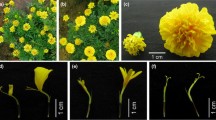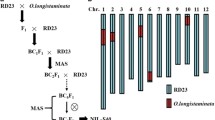Abstract
We have obtained one plant regenerated from rye tissue culture which showed a high percentage of polyembryonic seeds in its progeny. The mutation inducing the development of extra embryos is also influencing erroneous cell division, mitosis and meiosis. The genetic analysis indicated that the aptitude for polyembryonic seed formation is a heritable trait controlled by a dominant gene. However, for expression of the phenotype the female parent should have a specific cytoplasm.
Similar content being viewed by others
References
Chen LFO, Heer HE, Palmer RG (1985) The frequency of polyembryonic seedlings and polyploids from ms1 soybean. Theor Appl Genet 69:271–277
Clark JK, Sheridan WF (1991) Isolation and characterization of 51 embryo-specific mutations of maize. Plant Cell 3:935–951
Ganeshaiah KN, Uma Shaanker R, Joshi NV (1991) Evolution of polyembryony: Consequences to the fitness of mother and offspring. J Genet 70:103–127
Green AGH, Salisbury PA (1983) Inheritance of polyembryony in flax (Linum usitatissimum L.). Can J.Genet Cytol 25:117–121
Lanaud C (1988) Origin of haploids and semigamy in Theobroma cacao L. Euphytica 38:221–228
Lashermes P, Beckert M (1988) Genetic control of maternal haploid in maize (Zea mays L) and selection of haploid inducing lines. Theor Appl Genet 76:405–410
Linacero R, Vázquez AM (1992a) Cytogenetic variation in rye regenerated plants and their progeny. Genome 35:428–430
Linacero R, Vázquez AM (1992b) Genetic analysis of chlorophyll deficient somaclonal variants in rye. Genome 35:981–984
Linacero R, Vázquez AM (1992c) Somatic embryogenesis in polyembryonic Secale cereale L. Plant Cell Rep 12:26–28
Linacero R, Vázquez AM (1993) Somaclonal variation in rye. Mutation Res 302:201–205
Maheshwari P (1950) An introduction to the embryology of angiosperms McGraw-Hill, New-York
Meinke DW (1991a) Perspectives on genetic analysis of plant embryogenesis. Plant Cell 3:857–866
Meinke DW (1991b) Embryonic mutants of Arabidopsis thaliana. Dev Genet 12:382–387
Murray BE (1985) Studies of haploid-diploid twins in flax (Linum usitatissimum) Can J Genet Cytol 27:371–379
Turcotte EL, Feaster CV (1974) Methods of producing haploids: semigametic production of cotton haploids. In: Kasha KJ (ed.) Haploids in higher plants. Advances and potential Proceedings of the first international symposium Guelph, pp 53–64
Vázquez AM, Espino FJ, Rueda J, Candela M, Sendino AM (1991) A comparative study of somatic embryogenesis in Secale vavilovii. Plant Cell Rep 10:265–268
Zhou SQ, Qian DQ, Cao XY (1991) Induction of parthenogenesis and chromosome behavior in plants of parthenogenetic origin in cotton (Gossypium hirsutum). Genome 34:255–260
Author information
Authors and Affiliations
Rights and permissions
About this article
Cite this article
Linacero, R., Vázquez, A.M. Genetic analysis of a polyembryonic mutant in rye. Sexual Plant Reprod 7, 290–296 (1994). https://doi.org/10.1007/BF00227712
Received:
Accepted:
Issue Date:
DOI: https://doi.org/10.1007/BF00227712




